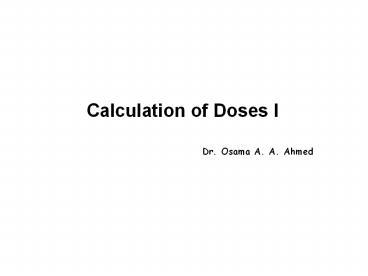Calculation of Doses I - PowerPoint PPT Presentation
Title:
Calculation of Doses I
Description:
Dr. Osama A. A. Ahmed Dose of a drug: ... the amount that ordinarily produces the medicinal effect intended in the infant or ... Time after drug administration ... – PowerPoint PPT presentation
Number of Views:336
Avg rating:3.0/5.0
Title: Calculation of Doses I
1
Calculation of Doses I
Dr. Osama A. A. Ahmed
2
Dose Definitions
- Dose of a drug the quantitative amount
administered or taken by a patient for the
intended medicinal effect - Single dose the amount taken at one time
- Total dose (Daily dose) the amount taken during
the course of therapy (may be subdivided in
divided doses) - Dosage regimen the schedule of dosing (4 times
per day for 10 days)
3
Dose Definitions
- Usual adult dose the amount that ordinarily
produces the medicinal effect intended in the
adult patient - Usual pediatric dose the amount that
ordinarily produces the medicinal effect intended
in the infant or child patient - Usual dosage range the quantitative range or
amounts of the drug that may be prescribed within
the guidelines of usual medical practice - Median effective dose the amount that produces
the desired intensity or effect in 50 of the
individuals tested. - Minimum effective concentration
- the minimum concentration determined
- that can be expected to produce the drugs
- desired effects in a patient.
- Minimum toxic concentration
- The base level of blood serum concentration that
produces dose-related toxic effects.
4
Dose Measurement
- Doses are measured and administered by
professional and paraprofessional personnel in
case of institutional setting. - adults or childs parents are generally measures
and administers medication in the home setting. - Household measures
Household measure (Abbreviation) ounce Metric system
1 teaspoonful (tsp) 1 tablespoonful (tbsp) 1/6 fluidounce 1/2 fluidounce 5 ml 15 ml f f ss
5
Dose Measurement
- Household measures
- Calibrated droppers
- US Pharmacopeia, official medicinal dropper held
vertically delivers approximately 20 drops water
per millilitre. - A drop (abbreviated gtt) doesnt represent a
definite quantity (few liquids have the same
surface and flow characteristics as water).
Signa Label dose
f i One teaspoonful 5 ml
f ii One dessertspoonful 10 ml
f ss One tablespoonful 15 ml
f One coffee cupful 30
m One drop
6
Dose Measurement
- Case 1
- A physician asks a pharmacist to calculate the
dose of a cough syrup so that it may be safely
administered dropwise to a child. The cough syrup
contains the active ingredient dextromethorphan
HBr, 30 mg/15 ml, in a 120- ml bottle. Based on
the childs weight and literature references, the
pharmacist determines the dose of
dextromethorphan HBr to be 1.5 mg for the child. - The medicine dropper to be dispensed with the
medication is calibrated by the pharmacist and
shown to deliver 20 drops of the cough syrup per
1 ml. - Calculate the dose in drops, for the child.
- Answer
- 30 mg dextromethorphan HBr
15 ml - 1.5 mg dextromethorphan HBr
X ml - X 15 1.5/30 0.75 ml
- Number of drops of cough syrup in 0.75 ml dose
- 1 ml 20 drops of cough
syrup - 0.75 ml X drops of cough
syrup - X 0.75 20/1 15 drops of cough syrup
7
Calculation of doses
- Patient Parameters
- Geriatric medicine or geriatrics is the field
that encompasses the management of illness in the
elderly - Pediatrics is the branch of medicine that deals
with disease in children from birth through
adolescence. - Neonate (newborn) from birth to 1 month, neonate
is considered premature if born less than 37
weeks gestation - Infant 1 month to 1 year
- Early childhood 1 year through 5 years
- Late childhood 6 years through 12 years
- Adolescence 13 years through 17 years of age
8
Calculation of doses
- Patient Parameters
- According to age
- Child and infant doses
- Youngs rule
- Cowlings rule
- Frieds rule for infants
9
Calculation of doses
- Patient Parameters
- According to body weight
- Clarks rule
- According to body surface area (BSA)
- To determine patients BSA, use standard Nomogram
or this equation
10
Calculation of doses
- If the adult dose of phenobarbital is 15 mg, what
will be the dose for an 8 year-old child? - Youngs rule
- (8/812)X 15 6 mg
- Cowlings rule
- (9/24)X 15 5.625






























![[PDF] Pharmacy Calculations Made Easy: PTCB & NAPLEX Test and Exam Prep for Pharmacy Technicians PLUS 2 FULL Practice Tests Full PowerPoint PPT Presentation](https://s3.amazonaws.com/images.powershow.com/10086646.th0.jpg?_=20240726102)
